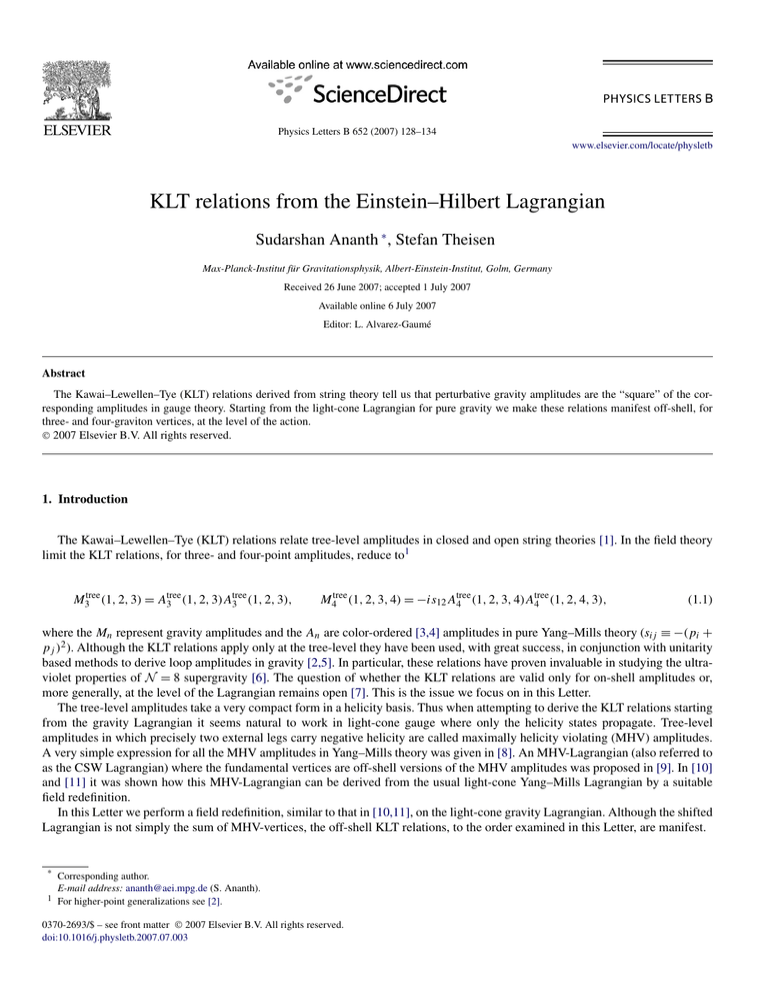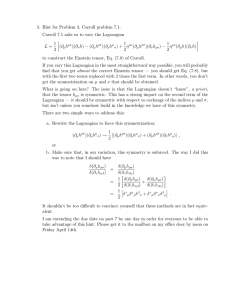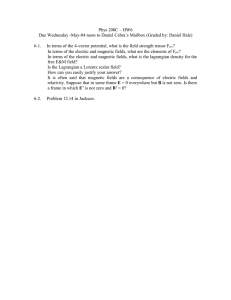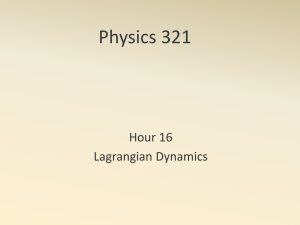
Physics Letters B 652 (2007) 128–134
www.elsevier.com/locate/physletb
KLT relations from the Einstein–Hilbert Lagrangian
Sudarshan Ananth ∗ , Stefan Theisen
Max-Planck-Institut für Gravitationsphysik, Albert-Einstein-Institut, Golm, Germany
Received 26 June 2007; accepted 1 July 2007
Available online 6 July 2007
Editor: L. Alvarez-Gaumé
Abstract
The Kawai–Lewellen–Tye (KLT) relations derived from string theory tell us that perturbative gravity amplitudes are the “square” of the corresponding amplitudes in gauge theory. Starting from the light-cone Lagrangian for pure gravity we make these relations manifest off-shell, for
three- and four-graviton vertices, at the level of the action.
© 2007 Elsevier B.V. All rights reserved.
1. Introduction
The Kawai–Lewellen–Tye (KLT) relations relate tree-level amplitudes in closed and open string theories [1]. In the field theory
limit the KLT relations, for three- and four-point amplitudes, reduce to1
tree
M3tree (1, 2, 3) = Atree
3 (1, 2, 3)A3 (1, 2, 3),
tree
M4tree (1, 2, 3, 4) = −is12 Atree
4 (1, 2, 3, 4)A4 (1, 2, 4, 3),
(1.1)
where the Mn represent gravity amplitudes and the An are color-ordered [3,4] amplitudes in pure Yang–Mills theory (sij ≡ −(pi +
pj )2 ). Although the KLT relations apply only at the tree-level they have been used, with great success, in conjunction with unitarity
based methods to derive loop amplitudes in gravity [2,5]. In particular, these relations have proven invaluable in studying the ultraviolet properties of N = 8 supergravity [6]. The question of whether the KLT relations are valid only for on-shell amplitudes or,
more generally, at the level of the Lagrangian remains open [7]. This is the issue we focus on in this Letter.
The tree-level amplitudes take a very compact form in a helicity basis. Thus when attempting to derive the KLT relations starting
from the gravity Lagrangian it seems natural to work in light-cone gauge where only the helicity states propagate. Tree-level
amplitudes in which precisely two external legs carry negative helicity are called maximally helicity violating (MHV) amplitudes.
A very simple expression for all the MHV amplitudes in Yang–Mills theory was given in [8]. An MHV-Lagrangian (also referred to
as the CSW Lagrangian) where the fundamental vertices are off-shell versions of the MHV amplitudes was proposed in [9]. In [10]
and [11] it was shown how this MHV-Lagrangian can be derived from the usual light-cone Yang–Mills Lagrangian by a suitable
field redefinition.
In this Letter we perform a field redefinition, similar to that in [10,11], on the light-cone gravity Lagrangian. Although the shifted
Lagrangian is not simply the sum of MHV-vertices, the off-shell KLT relations, to the order examined in this Letter, are manifest.
* Corresponding author.
E-mail address: ananth@aei.mpg.de (S. Ananth).
1 For higher-point generalizations see [2].
0370-2693/$ – see front matter © 2007 Elsevier B.V. All rights reserved.
doi:10.1016/j.physletb.2007.07.003
S. Ananth, S. Theisen / Physics Letters B 652 (2007) 128–134
129
2. Yang–Mills
We start by sketching schematically, the proposal of [10,11] for Yang–Mills. The light-cone Yang–Mills Lagrangian is of the
form
L ∼ L+− + L++− + L+−− + L++−− ,
(2.1)
where the indices, in no particular order, refer to helicity. The field redefinition maps the first two terms (the kinetic and one cubic
term) into a purely kinetic term. This transformation also generates an infinite series of higher order terms producing exactly the
MHV-Lagrangian
LY M ∼ L+− + L+−− + L++−− + L+++−− + L++++−− + · · · + L(+)n −− + · · · .
(2.2)
Again, this is merely a formal way of writing the Lagrangian. For example, L++−− receives contributions from the two inequivalent
orderings tr(AĀAĀ) and tr(AAĀĀ) where A and Ā are gluons of helicity2 +1 and −1, respectively. Each trace is multiplied by an
off-shell continuation (cf. Appendix A) of the appropriate Parke–Taylor amplitude [4,8]
kl4
,
i=1 i(i + 1)
n
n + 1 ≡ 1.
(2.3)
We will not go into details regarding the derivation of these results which can be found in [10–13]. The analysis in the gravity case
is completely analogous and is presented in detail in Section 3. The hope is that a similar field redefinition in pure gravity will
generate interaction terms which make KLT factorization manifest. The purpose of this Letter is to examine this issue.
3. Gravity in light-cone gauge
We follow closely, in this section, the light-cone formulation of gravity in [14]. Here, we only review the key features of this
formulation and refer the reader to Appendix C in [14] for a detailed derivation of the results presented below. The Einstein–Hilbert
action reads
√
1
SEH = d 4 x L = 2 d 4 x −gR,
(3.1)
2κ
where g = det gμν and R is the curvature scalar. Light-cone gauge is chosen by setting
g−− = g−i = 0,
i = 1, 2.
(3.2)
Our conventions and notation are explained in Appendix A. The metric is parameterized as follows
ψ
g+− = −e 2 ,
gij = eψ γij .
(3.3)
The field ψ is real while γij is a 2 × 2 real, symmetric, unimodular matrix. The R−i = 0 constraint allows us to eliminate g −i . From
the R−− = 0 constraint we find
ψ=
1 1 ∂− γ ij ∂− γij .
2
4 ∂−
(3.4)
The Lagrangian density now reads
1 √ +−
−g 2g R+− + g ij Rij .
2
2κ
We expand this to find [15]
ψ
1
1
3
1
1
3
1
L = 2 eψ
∂+ ∂− ψ − ∂+ γ ij ∂− γij − e 2 γ ij
∂i ∂j ψ − ∂i ψ∂j ψ − ∂i γ kl ∂j γkl + ∂i γ kl ∂k γj l
2
2
2
8
4
2
2κ
1 − 3 ψ ij 1
1
− e 2 γ
Ri Rj ,
2
∂− ∂−
L=
(3.5)
(3.6)
where
3
1
1
Ri = eψ − ∂− γ j k ∂i γj k + ∂− ∂i ψ − ∂i ψ∂− ψ − ∂k eψ γ j k ∂− γij .
2
2
2
This is the closed form of the Lagrangian.
2 The helicity label assumes that the particle is outgoing.
(3.7)
130
S. Ananth, S. Theisen / Physics Letters B 652 (2007) 128–134
3.1. The perturbative expansion
In order to obtain a perturbative expansion of the metric we choose
1
h + h̄
−i(h − h̄)
γij = eκH ij , H = √
,
−h − h̄
2 −i(h − h̄)
(3.8)
where h and h̄ represent gravitons of helicity +2 and −2, respectively. The light-cone Lagrangian density for pure gravity, to order
κ 2 [14], reads3
¯
∂ ∂¯
∂2
∂¯ 2
∂ ∂
2
2
h̄ h̄ − h̄ 2 h̄
L = h̄h + 2κ h̄∂−
h h − h 2 h + 2κh∂−
∂− ∂−
∂− ∂−
∂−
∂−
1
∂ ∂¯
1
¯ − h̄ + ∂− h∂ ∂¯ h̄)
+ 2κ 2 2 (∂− h∂− h̄) 2 (∂− h∂− h̄) + 3 (∂− h∂− h̄)(∂ ∂h∂
∂−
∂−
∂−
1
∂ ∂¯
∂ ∂¯
¯
¯
¯
¯
− 2 (∂− h∂− h̄) 2∂ ∂hh̄ + 2h∂ ∂ h̄ + 9∂h∂ h̄ + ∂h∂ h̄ −
h∂− h̄ − ∂− h h̄
∂−
∂−
∂−
1 ¯
1
¯ h̄
¯ h̄)h∂ h̄ − 2 (2∂− h∂ h̄ + ∂− ∂hh̄ − h∂− ∂ h̄)∂h
− 2 (2∂h∂− h̄ + h∂− ∂¯ h̄ − ∂− ∂h
∂−
∂−
1 ¯
¯ h̄) 1 (2∂− h∂ h̄ + ∂− ∂hh̄ − h∂− ∂ h̄)
(2∂h∂− h̄ + h∂− ∂¯ h̄ − ∂− ∂h
−
∂−
∂−
¯ ¯
∂
¯ h̄ + h∂ ∂¯ h̄ + 2∂h∂
¯ h̄ + 3 ∂ h∂− h̄ + 3∂− h ∂ ∂ h̄ .
− hh̄ ∂ ∂h
(3.9)
∂−
∂−
As in (2.1) the three-vertex terms are of the form (−, +, +) and (+, −, −). In analogy to Yang–Mills, a solution to the self-duality
condition
i αβ
Rαβρσ ,
Rμνρσ = μν
(3.10)
2
is
¯
∂¯ 2
∂ ∂¯
2
h̄ = 0,
h + 2κ∂−
(3.11)
h h − h 2 h = 0,
∂− ∂−
∂−
where the second relation is the h̄ equation of motion (at h̄ = 0). Thus, as in Yang–Mills, we will map the first two terms in (3.9) to
a free theory. Further discussions regarding this point may be found in [12].
3.2. The field redefinition
We seek a transformation (h, h̄) → (C, C̄) such that4
¯
K = −h̄∂+ ∂− h + h̄V (h) = −C̄∂+ ∂− C + C̄∂ ∂C,
where
2
¯ + κ∂−
V (h) = ∂ ∂h
¯
∂¯ 2
∂ ∂¯
h h−h 2 h .
∂− ∂−
∂−
(3.12)
(3.13)
The remaining three- and four-point vertices in (3.9) all involve exactly two negative helicity gravitons. Since MHV amplitudes
also involve exactly two negative helicity legs, we aim to preserve this structure.5 In analogy with Yang–Mills, we choose h to be a
function of C alone while h̄ is chosen to be a function of both C and C̄. This field redefinition is not unique and we will comment
on this below.
To find the explicit transformation, which is in fact a canonical
transformation on the phase space with coordinates (C, πC ), we
start with a generating function of the form G(C, πh ) = g(C)πh . Then
∂L
δG
δg
δG
h=
= g(C).
= ∂− C̄ =
=
πh ,
πC ≡
(3.14)
∂(∂+ C)
δC
δC
δπh
3 As seen in Appendix C of [14], a field redefinition which removes occurrences of ∂ from the interaction terms has been performed.
+
4 Note that the d’Alembertian is = 2(∂ ∂¯ − ∂ ∂ ). See Appendix A for further details.
+ −
5 We point out that higher order terms in (3.6) do not possess this structure.
S. Ananth, S. Theisen / Physics Letters B 652 (2007) 128–134
Since πh = ∂− h̄ we have
δh(x)
,
∂− C̄(y) = d 3 x ∂− h̄(x)
δC(y)
131
(3.15)
where the integral is performed on a surface of constant x + . The Lagrangian density then reads (here and below we drop surface
terms)
¯
¯ = ∂− C̄∂+ C − ∂− C̄ ∂ ∂ C.
L = −C̄∂+ ∂− C + C̄∂ ∂C
∂−
Using (3.15) the Lagrangian becomes
δh(y)
∂ ∂¯
.
L = d 3 x ∂− h̄(x)∂+ h(x) − d 3 x d 3 y ∂− h̄(y) C(x)
∂−
δC(x)
We want this to be equal to
1 3
L = d x ∂− h̄(x)∂+ h(x) − ∂− h̄(x) V h(x) ,
∂−
(3.16)
(3.17)
(3.18)
implying that
¯
∂ ∂¯
∂ ∂¯
∂¯ 2
∂ ∂¯
δh(x)
h(x) + κ∂−
h h − h 2 h (x) = d 3 y C(y)
.
∂−
∂− ∂−
∂−
δC(y)
∂−
In momentum space, this becomes
¯
δh(p)
k̄ l
l¯2
p p̄
3 mm̄
3
3 (3)
h(p− ) − d m
C(m)
− 2 h(k)h(l).
= −κ d k d lδ (p − k − l)(k− + l− )
p−
m−
δC(m)
k− l− l−
(3.19)
(3.20)
For h, we choose the ansatz
h(p) =
∞ n
n=1
d 3 ki Z (n) (p1 , k1 , . . . , kn )C(k1 ) · · · C(kn ),
(3.21)
i=1
so (3.20) implies
pp̄ k k̄
l l¯
3
3
d kd l
−
−
Z (2) (p, k, l)C(k)C(l)
p− k − l −
¯
k̄ l
l¯2
− 2 C(k)C(l)δ (3) (p − k − l).
= −κ d 3 kd 3 l(k− + l− )
k− l− l−
(3.22)
Thus
Z (1) (p, k) = δ (3) (p − k),
¯2
¯
2
l
k̄
k̄ l
2
2 + k 2 − 2 k− l−
[kl] (3)
κ
κ p−
l−
−
(2)
(3)
δ
(p
−
k
−
l)
=
−
δ (p − k − l).
Z (p, k, l) = (k− + l− )
¯
p
p̄
k
k̄
l
l
2
2 k− l− kl
−
−
p−
k−
(3.23)
l−
From (3.15) we also find
p− h̄(p) = p− C̄(p) −
d 3 k d 3 l k− Z (2) (−k, −p, l) + Z (2) (−k, l, −p) C̄(k)C(l) + · · · ,
which can be rewritten as
k 3 [kl]
h̄(p) = C̄(p) + κ d 3 k d 3 l 2−
C̄(k)C(l) + · · · .
p− l− kl
(3.24)
(3.25)
It is straightforward to work out a recursion relation for the coefficients Z (n) which can then be solved to any desired order. We will
not present the details here.
132
S. Ananth, S. Theisen / Physics Letters B 652 (2007) 128–134
3.3. The shifted gravity action
After performing the field redefinition described in the previous section we find that the gravity action, to order κ 2 , is
d p C̄(−p)p C(p) + κ
4
2
d 4p d 4k d 4l
kl6
C(p)C̄(k)C̄(l)δ (4) (p + k + l)
lp2 pk2
kl8 [kl]
C(p)C(q)C̄(k)C̄(l)δ (4) (p + q + k + l)
klkpkqlplqpq2
2
d 4 p d 4 q d 4 k d 4 l J (p, q, k, l)p 2 + K(p, q, k, l)k 2 C(p)C(q)C̄(k)C̄(l)δ (4) (p + q + k + l).
+κ
+ κ2
d 4p d 4q d 4k d 4l
(3.26)
We stress that the coefficients in the action above are off-shell. Note that the four-graviton amplitude does not receive exchange
contributions due to the structure of the action at the cubic level after the field redefinitions (3.21) and (3.25). The functions J
and K turn out to be fairly complicated but are irrelevant for on-shell four-point scattering since the third line vanishes on-shell.
In particular, when interaction vertices are proportional to the free equations of motion they can be eliminated by a suitable field
redefinition [16]. The required field redefinitions are6
C(p) → C(p) − κ 2 d 4 q d 4 k d 4 l K(k, q, −p, l)C(k)C(q)C̄(l)δ (4) (−p + q + k + l),
C̄(p) → C̄(p) − κ 2 d 4 q d 4 k d 4 l J (−p, q, k, l)C̄(k)C̄(l)C(q)δ (4) (−p + q + k + l),
(3.27)
and these eliminate the third line in (3.26). The light-cone action for gravity to order κ 2 thus reads
d 4 p C̄(−p)p 2 C(p) + κ
+ κ2
d 4p d 4q d 4k d 4l
d 4p d 4k d 4l
kl6
C(p)C̄(k)C̄(l)δ (4) (p + k + l)
lp2 pk2
kl8 [kl]
C(p)C(q)C̄(k)C̄(l)δ (4) (p + q + k + l).
klkpkqlplqpq2
(3.28)
These off-shell vertices clearly factorize into products of off-shell MHV vertices in Yang–Mills. In particular this confirms, offshell, the relations (1.1) for three- and four-point vertices. It will be interesting to see if this KLT factorization extends to higher
orders in the action where non-MHV vertices appear.
In contrast to the Yang–Mills case, the MHV vertices in gravity appear only after a further field redefinition (3.27) that removes
interaction vertices proportional to the free equations of motion. This was to be expected given that the gravity Lagrangian, unlike
Yang–Mills, does not stop at quartic order and that the MHV gravity amplitudes are non-holomorphic [17]. Furthermore MHV
vertices in the gravity Lagrangian are not sufficient to compute all the non-MHV diagrams, at least for our choice of field variables.
For example the 5-point amplitude M tree (+, +, −, −, −) has contributions from the MHV vertices but also from a direct contact
vertex present in the original Lagrangian.7 The five-point MHV amplitude M tree (+, +, +, −, −) is special in that it has three
contributions: one term from the original Lagrangian and two from the field redefinition acting on the three- and four-point vertices.
Otherwise, as in Yang–Mills, all n-point (n > 5) MHV amplitudes are generated by the field redefinitions alone.
The discussion in the main body of this Letter dealt with light-cone gravity at tree-level. At the loop level, field redefinitions have
to be considered with much greater care. If the Jacobian of the field redefinition is not unity it will lead to additional interaction
terms [16]. Even if the Jacobian is classically one there may be anomalies which lead to additional interaction terms as proposed in
the context of the MHV Lagrangian for Yang–Mills in [10]; see also the discussion in [12,13].
An interesting question is whether the Lagrangians of N = 8 supergravity and N = 4 super Yang–Mills share a similar relationship. Since there exist superfield formulations, in light-cone gauge, for both these theories [19] a similar analysis is certainly worth
performing.
Acknowledgements
We thank Lars Brink, Hermann Nicolai, Alexei Rosly, Adam Schwimmer and Hidehiko Shimada for discussions.
6 This field redefinition changes the structure h = h(C) to h = h(C, C̄) but affects only four- and higher-point vertices. This demonstrates the non-uniqueness of
the field redefinition in Section 3.2.
7 In [18], the five-point non-MHV graph is simply a sum of MHV-exchange diagrams. In our case there is also a direct contribution: this is not surprising since, in
our Lagrangian, we have eliminated the three-vertex M(+, +, −) and so do not have a contribution equivalent to D2 in Eq. (3.14) of that reference.
S. Ananth, S. Theisen / Physics Letters B 652 (2007) 128–134
133
Appendix A. Conventions and notation
We work with the metric (−, +, +, +) and define
1 x± = √ x0 ± x3 ,
2
1
∂± = √ (∂0 ± ∂3 ).
2
x + plays the role of light-cone time and ∂+ the light-cone Hamiltonian. ∂− is now a spatial derivative and its inverse,
using the prescription in [20]. We define
1 x = √ x 1 + ix 2 ,
2
1 1
x̄ = √ x − ix 2 ,
2
∂
∂¯ ≡
=
∂x
∂
∂≡
=
∂ x̄
(A.1)
1
∂− ,
is defined
1
√ (∂1 − i∂2 ),
2
1
√ (∂1 + i∂2 ).
2
A four-vector pμ may be expressed as a bispinor pa ȧ using the σ μ = (−1, σ ) matrices
√ −p−
−p0 + p3 p1 − ip2
p
= 2
.
pa ȧ ≡ pμ σ μ a ȧ =
p
−p+
p1 + ip2 −p0 − p3
(A.2)
(A.3)
The determinant of this matrix is
det(pa ȧ ) = −2(p p̄ − p+ p− ) = −p μ pμ .
(A.4)
When the vector pμ is light-like we have p+ = pp−p̄ which is the on-shell condition. We then define holomorphic and antiholomorphic spinors8
1
1
24
24
p−
p−
∗
λa = √
(A.5)
,
λ̃ȧ = −(λa ) = − √
,
p − −p
p− −p̄
such that λa λ̃ȧ agrees with (A.3) on-shell. We define the off-shell holomorphic and anti-holomorphic spinor products [13]
j
i
√ p i p−
− p j p−
ij = 2 ,
i pj
p−
−
j
i
√ p̄ i p−
− p̄ j p−
[ij ] = 2 .
i pj
p−
−
(A.6)
Their product is
ij [ij ] = sij ≡ −(pi + pj )2 .
References
[1]
[2]
[3]
[4]
[5]
[6]
[7]
[8]
[9]
[10]
[11]
[12]
[13]
[14]
[15]
H. Kawai, D.C. Lewellen, S.H.H. Tye, Nucl. Phys. B 269 (1986) 001.
Z. Bern, L.J. Dixon, M. Perelstein, J.S. Rozowsky, Nucl. Phys. B 546 (1999) 423, hep-th/9811140.
F.A. Berends, W. Giele, Nucl. Phys. B 294 (1987) 700.
L. Dixon, TASI (1995) 539, hep-ph/9601359.
Z. Bern, L.J. Dixon, M. Perelstein, J.S. Rozowsky, Phys. Lett. B 444 (1998) 273, hep-th/9809160.
Z. Bern, J. Carrasco, L. Dixon, H. Johansson, D. Kosower, R. Roiban, hep-th/0702112.
Z. Bern, A.K. Grant, Phys. Lett. B 457 (1999) 23, hep-th/9904026;
Z. Bern, Living Rev. Rel. 5 (2002) 5, gr-qc/0206071.
S.J. Parke, T.R. Taylor, Phys. Rev. Lett. 56 (1986) 2459;
F.A. Berends, W.T. Giele, Nucl. Phys. B 306 (1988) 759.
F. Cachazo, P. Svrcek, E. Witten, JHEP 0409 (2004) 006, hep-th/0403047.
A. Gorsky, A. Rosly, JHEP 0601 (2006) 101, hep-th/0510111.
P. Mansfield, JHEP 0603 (2006) 037, hep-th/0511264.
J. Ettle, T. Morris, JHEP 0608 (2006) 003, hep-th/0605121;
J. Ettle, C. Fu, J. Fudger, P. Mansfield, T. Morris, hep-th/0703286.
A. Brandhuber, B. Spence, G. Travaglini, K. Zoubos, arXiv: 0704.0245 [hep-th].
S. Ananth, L. Brink, R. Heise, H.G. Svendsen, Nucl. Phys. B 753 (2006) 195, hep-th/0607019.
J. Scherk, J.H. Schwarz, Gen. Relativ. Gravit. 6 (1975) 537;
I. Bengtsson, M. Cederwall, O. Lindgren, GOTEBORG-83-55, 1983.
8 When working with a Lorentzian signature, choosing λ̃ = ±(λ )∗ ensures that p is real.
a
ȧ
a ȧ
(A.7)
134
S. Ananth, S. Theisen / Physics Letters B 652 (2007) 128–134
[16] A. Salam, J.A. Strathdee, Phys. Rev. D 2 (1970) 2869;
G.’t Hooft, M. Veltman, Diagrammar, CERN Report No. 73-9, 1973;
H. Georgi, Nucl. Phys. B 361 (1991) 339;
C. Arzt, Phys. Lett. B 342 (1995) 189.
[17] F.A. Berends, W.T. Giele, H. Kuijf, Phys. Lett. B 211 (1988) 91.
[18] N.E.J. Bjerrum-Bohr, D.C. Dunbar, H. Ita, W.B. Perkins, K. Risager, JHEP 0601 (2006) 009, hep-th/0509016.
[19] L. Brink, O. Lindgren, B.E.W. Nilsson, Nucl. Phys. B 212 (1983) 401;
S. Ananth, L. Brink, P. Ramond, JHEP 0407 (2004) 082, hep-th/0405150;
S. Ananth, L. Brink, P. Ramond, JHEP 0505 (2005) 003, hep-th/0501079.
[20] S. Mandelstam, Nucl. Phys. B 213 (1983) 149.






